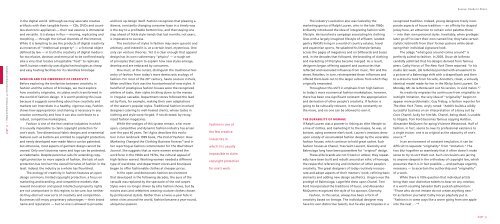Testimony of David Wolfe, Creative Director The ... - Public Knowledge
Testimony of David Wolfe, Creative Director The ... - Public Knowledge
Testimony of David Wolfe, Creative Director The ... - Public Knowledge
Create successful ePaper yourself
Turn your PDF publications into a flip-book with our unique Google optimized e-Paper software.
E s s a y s : Ready t o S h a r e<br />
in the digital world. Although we may associate creative<br />
and lock up design itself. Fashion recognizes that pleasing a<br />
<strong>The</strong> industry’s evolution also was fueled by the<br />
recognized tradition. Indeed, young designers freely incor-<br />
artifacts with their tangible forms — CDs, DVDs and count-<br />
diverse, constantly changing consumer base in a timely way<br />
marketing genius <strong>of</strong> Ralph Lauren, who in the late 1960s<br />
porate aspects <strong>of</strong> house tradition — an affinity for draped<br />
less electronic appliances — their real essence is immaterial<br />
is the key to a pr<strong>of</strong>itable bottom line, and that staying one<br />
brilliantly introduced the idea <strong>of</strong> integrating fashion with<br />
jersey here, an attraction to certain color palettes there<br />
and versatile. It is always in flux — moving, replicating and<br />
step ahead <strong>of</strong> fickle style trends that last months, not years,<br />
lifestyle. He launched a campaign associating his clothing<br />
— into their own personal styles. Inevitably, when protégés<br />
morphing — through the virtual channels <strong>of</strong> the Internet.<br />
is imperative to success.<br />
lines with a largely imagined lifestyle <strong>of</strong> affluent, landed-<br />
later go <strong>of</strong>f to start their own named line, they take certain<br />
While it is tempting to see the products <strong>of</strong> digital creativity<br />
<strong>The</strong> evolution <strong>of</strong> styles in fashion may seem quixotic and<br />
gentry WASPs living in a world <strong>of</strong> country estates, travel<br />
stylistic leitmotifs from their former patrons while devel-<br />
as instances <strong>of</strong> “intellectual property” — a fictional object<br />
arbitrary, and indeed it is, at a certain level, mysterious. One<br />
and equestrian sports. He splashed his lifestyle fantasy<br />
oping their individual signature look.<br />
defined by law — in truth the creativity <strong>of</strong> digital media is<br />
only can venture theories. Yet it is clear enough that apparel<br />
across the pages <strong>of</strong> magazines and on billboards and buses<br />
<strong>The</strong> adage “what goes around comes around” is<br />
far too elusive, abstract and mercurial to be confined easily.<br />
design has its own rudimentary “physics” — a rough set<br />
and, in the decades that followed, the branding <strong>of</strong> clothing<br />
perfectly suited to fashion. In 2003, Oscar de la Renta<br />
Like a virus that locates a hospitable “host” to replicate<br />
<strong>of</strong> principles that seem to explain how new styles emerge,<br />
and marketing <strong>of</strong> lifestyles became merged. As a result,<br />
candidly admitted that his designs derived from famous<br />
page 32 | Ready to Share: Fashion & the Ownership <strong>of</strong> Creativity<br />
itself, human creativity uses digital technologies as cheap<br />
and easy hosting facilities for its relentless bricolage.<br />
fashion and the ownership <strong>of</strong> creativity<br />
Before exploring the similarities between creativity in<br />
fashion and the culture <strong>of</strong> bricolage, we must explore<br />
how creativity originates, circulates and is transformed in<br />
the world <strong>of</strong> fashion design. It is worth probing this issue<br />
because it suggests something about how creativity and<br />
markets can interrelate in a healthy, vigorous way. Fashion<br />
shows how appropriation and sharing is necessary in any<br />
creative community and how it can also contribute to a<br />
robust, competitive marketplace.<br />
Fashion is one <strong>of</strong> the few creative industries in which<br />
it is usually impossible to claim copyright protection for<br />
one’s work. Two-dimensional fabric designs and ornamental<br />
features such as buttons are entitled to copyright protection,<br />
and newly developed man-made fabrics can be patented,<br />
develop and are embraced by consumers.<br />
One must, at the outset, distinguish the traditional hierarchy<br />
<strong>of</strong> fashion from today’s more democratic ecology <strong>of</strong><br />
fashion. For most <strong>of</strong> the 20 th century, haute couture in Paris,<br />
Milan and New York was the fountainhead <strong>of</strong> new styles. A<br />
handful <strong>of</strong> prestigious fashion houses were the recognized<br />
arbiters <strong>of</strong> taste, their styles trickling down to the masses<br />
in irregular cascades. Department stores followed the lead<br />
set by Paris, for example, making their own adaptations<br />
<strong>of</strong> the season’s popular styles. Traditional fashion involved<br />
designers catering to well-heeled clients, whose tastes in<br />
clothing and style were forged, if not dictated, by recognized<br />
fashion magazines.<br />
While the vestiges <strong>of</strong> this system remain, a far more<br />
open, competitive and dynamic fashion industry has arisen<br />
over the past 40 years. Teri Agins describes this evolution<br />
in her landmark 1999 book, <strong>The</strong> End <strong>of</strong> Fashion: How<br />
Marketing Changed the Clothing Business Forever, 6 and in<br />
Fashion is one <strong>of</strong><br />
the few creative<br />
industries in<br />
designers began <strong>of</strong>fering apparel and accessories that<br />
reflected and resonated influences from music, film and the<br />
street. Retailers, in turn, reinterpreted those influences and<br />
<strong>of</strong>fered them back out to the larger culture from which they<br />
originally emanated.<br />
Throughout this shift in emphasis from high fashion<br />
to today’s more ecumenical fashion marketplace, however,<br />
there has been one significant constant: the appropriation<br />
and derivation <strong>of</strong> other people’s creativity. If fashion is<br />
going to be culturally relevant, it must be constantly on<br />
the move, and no one can be allowed to own it.<br />
the durability <strong>of</strong> homage<br />
If Ralph Lauren was a pioneer in linking an elite lifestyle to<br />
a line <strong>of</strong> clothes, and marketing it to the masses, he was, at<br />
bottom, aping someone else’s work. Lauren’s creations drew<br />
upon a body <strong>of</strong> accumulated fashion design by the venerable<br />
fashion houses, which continue to hold great cachet. Such<br />
peers. Cathy Horyn <strong>of</strong> <strong>The</strong> New York Times reported: “In his<br />
studio last week, [de la Renta] pointed with amusement to<br />
a picture <strong>of</strong> a Balenciaga shift with a draped back and then<br />
to a dress he took from his wife, Annette’s, closet, a virtually<br />
identical model made for her in the 90s by Saint Laurent. On<br />
Monday, Mr. de la Renta sent out his version, in vivid melon.” 7<br />
As creativity migrates the continuum from originality to<br />
outright imitation, the very idea <strong>of</strong> “originality” begins to<br />
appear more problematic. Guy Trebay, a fashion reporter for<br />
<strong>The</strong> New York Times, wryly noted: “Adolfo builds a wildly<br />
successful business on an interpretation <strong>of</strong> a boxy suit by<br />
Coco Chanel; lucky for him Ms. Chanel, being dead, is unable<br />
to litigate. Tom Ford becomes famous copying Halston,<br />
Alexander McQueen for aping Vivienne Westwood. Half <strong>of</strong><br />
fashion, in fact, seems to owe its pr<strong>of</strong>essional existence to<br />
a single truism: one is as original as the obscurity <strong>of</strong> one’s<br />
source.” 8<br />
In an environment <strong>of</strong> constant emulation, it can be<br />
but otherwise, most aspects <strong>of</strong> garment design cannot be<br />
owned. Only one’s business name and logo can be protected,<br />
as trademarks. Despite perennial calls for extending copy-<br />
her reporting as fashion commentator for <strong>The</strong> Wall Street<br />
Journal. She suggests that as more women entered the<br />
workforce in the 1960s and 1970s, the cultural appeal <strong>of</strong><br />
which it is usually<br />
impossible to claim<br />
fashion houses as Chanel, Yves Saint Laurent, Givenchy and<br />
Balenciaga long have been pacesetters for “original” design.<br />
<strong>The</strong>se elite brands are not frozen in amber; they repeat-<br />
difficult to separate “originality” from “imitation.” <strong>The</strong><br />
two blur together so seamlessly that it <strong>of</strong>ten doesn’t make<br />
sense to try to sort them out. Such conclusions are jarring<br />
right protection to more aspects <strong>of</strong> fashion, the lack <strong>of</strong> such<br />
protection has not hurt the overall fortunes <strong>of</strong> fashion in the<br />
least. Indeed, the industry as a whole has flourished.<br />
<strong>The</strong> ecology <strong>of</strong> creativity in fashion features an open<br />
high fashion waned. Working women needed a different<br />
type <strong>of</strong> wardrobe, and department stores and boutiques<br />
began to <strong>of</strong>fer fashionable clothes at cheaper prices.<br />
In the open and democratic fashion environment<br />
copyright protection<br />
for one’s work.<br />
edly have been built and rebuilt around an ethic <strong>of</strong> homage,<br />
the respectful referencing and imitation <strong>of</strong> other people’s<br />
creativity. <strong>The</strong> great designers <strong>of</strong> today routinely incorporate<br />
and adopt aspects <strong>of</strong> their mentors’ work, refining basic<br />
to anyone steeped in the orthodoxy <strong>of</strong> copyright law, which<br />
presumes that it is in fact possible — and perhaps urgently<br />
necessary — to ascertain the authorship and “originality”<br />
<strong>of</strong> a work.<br />
design commons, limited copyright protection, a focus on<br />
that developed in the following decades, the aura <strong>of</strong> the<br />
elements and adding new design aesthetics. Ungaro was the<br />
While there is little question that individual artists<br />
marketing and branding, and competitive markets that<br />
catwalk was replaced by the spectacle <strong>of</strong> the red carpet.<br />
protégé <strong>of</strong> Balenciaga; Lagerfeld drew upon Chanel. Tom<br />
bring their own distinctive talents to bear on any creation,<br />
reward innovation and speed. Intellectual property rights<br />
Styles were no longer driven by elite fashion shows, but by<br />
Ford incorporated the traditions <strong>of</strong> Gucci, and Alexander<br />
it is worth recalling Salvador Dali’s puckish admonition:<br />
are not unimportant in this regime, to be sure, but neither<br />
movies stars and celebrities wearing couture clothes chosen<br />
McQueen recognized the style <strong>of</strong> his sponsor, Givenchy.<br />
“Those who do not imitate do not create anything new.”<br />
do they obstruct new sorts <strong>of</strong> creativity and competition.<br />
by pr<strong>of</strong>essional stylists. Rather than a twice-a-year fete in<br />
Fashion, in this sense, always has been a form <strong>of</strong><br />
Or as fashion journalist Cathy Horyn playfully put it,<br />
Businesses still enjoy proprietary advantages — their brand<br />
name and reputation — but no one is allowed to privatize<br />
select cities around the world, fashion became a year-round,<br />
ubiquitous passion.<br />
creativity based on lineage. <strong>The</strong> individual designer may<br />
have his own distinctive talents, but he also participates in a<br />
“Fashion is in some ways like a worm going from one apple<br />
into the next ….” 9<br />
page 33





